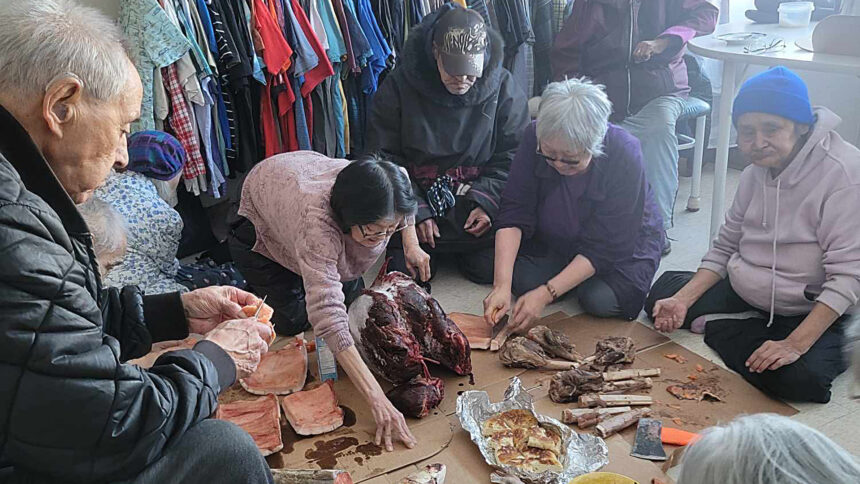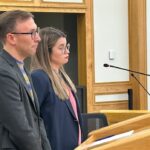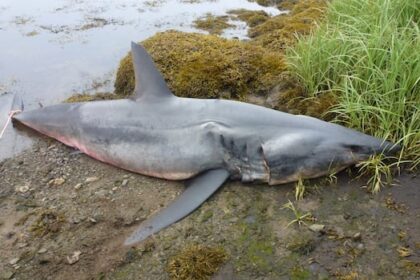A year ago, the food bank in Cambridge Bay, Kitikmeot Region, Nunavut, served about 250 families in the community of some 2,000 people. But that was in the era in which Inuit were receiving funding from the Hamlet Food Voucher Program (HFVP), which gave families $500 per month per child for food and an additional $250 per child under four for diapers. In March of 2025, Indigenous Services Canada ended the program. While it took time for the payments to cease in all communities, Leonard Langan, coordinator of the Cambridge Bay Wellness Centre Food Bank , reported the last funds reached his hamlet in July. “It sure helped a lot of families who are struggling financially to feed their families,” Langan told APTN News. “After it ended, we went up to 489 families who depended on the food bank. And we don’t have that big of a budget that we can sustain those numbers. “So the people who do come to the food bank, we can’t give them a whole lot of extra food. We just give out the basics, just to get them by. We give them whatever we can.” Currently, Langan said, his organization is working to coordinate their Christmas hamper program. “We try to get out 200 hampers for the Christmas season for the really needy families,” he said, “and it’s a struggle just to find funding to supply food for that many families.” Not being able to give community members who come to his food bank everything they need weighs upon Langan. “You feel kind of bad for the people who need it,” he said, “who come in and you can only give them a few items. You know it’s not going to last long, especially with people with three or four kids. It’s hard to give a little bag of food to somebody when you know it’s only going to last one meal or something.”More than 660 kilometres southeast in Baker Lake, Kivalliq Region, Mark Oklaga at the Abluqta Society Food Bank says his organization is also struggling. “The hunger situation is kind of pretty bad right now,” he told APTN. “After the [HFVP] went off, it’s like people are having a hard time now getting food.” As with the food bank in Cambridge Bay, Oklaga said, his organization has gone through periods where they didn’t have enough food to feed everybody that comes in. Fortunately, for the time being, the Abluqta Society Food Bank is able to meet everyone’s needs. Staff at Baker Lake, Nunavut’s Abluqta Society Food Bank prepare meals for community members. Photo: Abluqta Society Yet Oklaga said he’s alarmed by the increasing number of young children coming to eat hot lunches. “Sometimes it’s pretty sad seeing them come,” he said. “Some of them will say they never ate for how many days? I try not to get emotional. I get very sad, but I just try to keep my sadness in and try to help them in every way we can. I try to give leftovers to everyone.” Sabrina Maniapik is community wellness coordinator in Pangnirtung, Qikiqtaaluk Region, 1,400 kilometres east of Baker Lake. She said when the HFVP funding ended, the hot-lunch service at the community’s Sailavik Safe and Sober Drop-In Centre began getting busier every week. “We’re seeing families looking through social media [to see] if anyone has leftovers,” she said, “or the local radio, if anyone is giving away anything, just for [meals for] at least a day or two. It’s sad to see so many stories being told, that they’re in this situation. Especially food insecurities for children. “It’s not just for children, it’s for adults too, who cannot afford basic necessities.” In late September, Iqaluit’s Qajuqturvik Community Food Centre (QCFC) held a news conference to announce the demand for food—which has been growing since 2022—in the territory’s only city was becoming unmanageable. On one day in the preceding week, eight per cent of the population of Iqaluit came to eat hot lunches at the QCFC. “We feel the crushing demand of this in our dining room and in our kitchen,” Murdoch-Flowers said. Iqaluit pediatrician Dr. Sindu Govindapillai, executive director of the Arctic Children and Youth Foundation, called the situation, “the worst food-security crisis I have seen.” She pointed out that, according to Statistics Canada’s data from 2022, 79 per cent of children under 14 in Nunavut lived in situations of food insecurity. “Our patients, our clients, are going through desperate measures to get food for their children,” she said. APTN asks federal government if there is a ‘food crisis’ in Nunavut In the weeks following the QCFC press conference, APTN spoke with four experts, three Inuit and one non-Inuk, who were familiar with communities in different regions of Nunavut. All described the territory as experiencing a “hunger emergency” or “hunger crisis.” APTN requested a direct interview with a representative of Indigenous Services Canada (ISC) to discuss the decision to end the HFVP, to find out what kinds of outcomes ISC expected would result from the end of that program and to hear whether any contingency plans were in effect to respond to expanded hunger needs in the communities. ISC did not consent to an interview by phone or in person and directed us instead to send questions by email. When we did so, ISC sent a response that did not address most of the key issues of our questioning. On Oct. 14, APTN followed up by noting the answers with which ISC furnished us avoided the central subjects of our questions and asked again, “Does Indigenous Services believe there is at present, in October of 2025, a hunger emergency in Nunavut?” At that point, ISC stopped responding to APTN’s emails on the matter. Lori Idlout (NDP), MP for Nunavut, said the Liberal government’s decision to end the Hamlet Food Voucher Program “appeared to be purely political.” The end of the Voucher Program, and the future for similar programs Igloolik-born NDP MP Lori Idlout was elected to represent Nunavut in the House of Commons in 2021. She held the seat in the spring 2025 federal election. A lawyer with a history of activism supporting Inuit health and culture, she said the Liberal government’s decision to end the Hamlet Food Voucher Program “appeared to be purely political.” “When the program was running,” she told APTN, “people were telling me that their well-being improved so much for different reasons. They had a consistent, reliable source of funding that they knew they could buy enough groceries for their children, and because of it, people had other bills that they could pay, and their mental health improved, they said. “Their sense of well-being really improved for that time that the program was running.” She said when the HFVP ended, hundreds of families questioned why it was so abruptly discontinued. The HFVP was part of the Inuit Child First Initiative, which last spring the Liberal government voted to extend for another year, until March 31, 2026. Over the summer, Indigenous Services Minister Mandy Gull-Masty told CBC News her office was redesigning the ICFI, and that “It has to have fiscal sustainability. It has to have concrete funding in place … as something that you can access consistently.” Earlier this month, Gull-Masty told Nunatisaq News that her ministry was working with the community to redesign the program. She stressed that she hoped to find a means of maintaining and protecting the ICFI and ensuring solutions that allowed it to operate in the long-term. Idlout said Inuit families initiated a letter-writing campaign she believes helped get the program extended until 2026. “Even with the extension by a year,” she said, “huge limitations were put on it, and I’m still hearing from families that they need this program.” ‘One crisis after another’ Idlout told APTN she made inquiries to different ministers to understand the reasoning behind the decision to end the HFVP. She also discussed the issue with Nunavut Tunngavik Incorporated President Jeremy Tunraluk. “He was told by the minister that people are abusing the program,” she recalled. “And to me, it didn’t seem like an acceptable response, given that there are so few economic development opportunities for Nunavummiut.”Importantly, Idlout stressed the ongoing crisis is only one in a series that Inuit have endured for decades. “We’ve been in one crisis after another,” she said, “whether it’s the cost of living crisis, not enough housing crisis, and not enough opportunities to be economically independent. There are so many issues in Nunavut, and no matter how much we talk about these stories, the responses are never enough.” Idlout cites the hunger crisis as the biggest challenge Inuit are facing, specifically because of its direct impact on children. “If children can’t go to school with food in their bellies, they won’t learn. So if it’s harder for them to learn, it’ll be more challenging for them to graduate from grade 12,” she said. Given the history of crises involving consistent lacks of funding, Idlout said, she has trouble processing the rationale for ending a program designed to feed children. “I don’t think that trying to say that people were abusing the program is a sufficient response,” she said. Hunger in Nunavut is widespread enough that Pangnirtung’s Community Wellness Coordinator Sabrina Maniapik reported that she herself struggled to feed her family during the years she was not working and on social assistance while raising her young children. “There were days that, as a parent, I would not eat at least a day or two just to feed my family, my little ones, to have something in their tummy,” Maniapik told APTN. Read more: Food-security researcher says Nunavut gripped by ‘worst hunger crisis’ she’s seen Centre in Iqaluit says territory is in a food ‘crisis’ Contending with a painful legacy Idlout recalls the lowest points of Canada’s colonization of Inuit, including the RCMP’s slaughter of thousands of sled dogs between 1950 and 1970, and the forced relocation of Inuit from the Nunavik region along Quebec’s northernmost coast to the highest points of the Arctic as pawns in Canada’s territorial claim of sovereignty in the arctic. Inuit relocated to high-Arctic communities like Grise Fiord were referred to as “human flagpoles,” and though they were promised abundance, they arrived to find very little. The federal government, first under Stephen Harper and then under Justin Trudeau, has since apologized for both the forced relocation and the sled-dog slaughter. Yet, in spite of the formal apologies—more than a half-century after the wrongs in question—Idlout said these colonial assaults on Inuit, their communities and their way of life are fresh in the minds of many Nunavummiut facing a shortage of affordable food. “There’s all these broken promises,” she said, “[and] there’s nothing to substantiate why they would cut a program that was helping feeding families, that was helping to alleviate poverty to some extent.” The same concerns about Arctic sovereignty that moved 1950s prime minister Louis St. Laurent to forcibly relocate Inuit to the high Arctic are once again pressing. Last week, Inuit Tapiriit Kanatami President Natan Obed told the Senate’s Standing Committee on National Security, Defence and Veterans Affairs that if they wish to safeguard Arctic sovereignty, they will need to invest heavily in Inuit communities and infrastructure. He noted that Inuit families and hunters constantly traverse the territory and report anything out of the ordinary to their communities and to the Canadian Rangers, meaning the health and safety of Inuit living traditionally is closely connected with concerns about Canadian sovereignty in the region. “We focus on the need for Canada to invest more in the health and well-being of our people,” Obed told the committee, “to retain and support Inuit as the region’s future and most important resource. And we emphasize the need for Canada to enact a broader vision for bringing Nunangat into the rest of the country.” Idlout stressed concern that the current federal government under Mark Carney may not see the logic in this, as she believes the prime minister’s focus is on Arctic security rather than Arctic sovereignty. “Inuit and Northerners, they want to be engaged in Arctic security,” she said, “but they have too many barriers to be engaged. Inuit and Northerners do want to be defended as part of Canada, but they don’t only want military to come in to defend them. They want to be engaged with directly. “There needs to be more investments going to them so that they don’t have to live in overcrowded housing conditions, that they don’t have to send their kids to overcrowded schools or that they don’t have to leave their communities for basic medical care. “There’s a lot more spent on Arctic security than there is on Arctic sovereignty,” she added, “and we need to rebalance that.” More funding, and targets for funding The obvious answer to the ongoing circumstances experts are calling a hunger emergency is to increase funding for food. While it was in operation, the Hamlet Food Voucher Program did precisely that. Maniapik said that hunger isn’t being addressed properly by the governments with the power to improve circumstances for Inuit in Nunavut. “We need more resources, funding available for food insecurities,” she said. “We’re eating traditional meats. The men go hunting, and women go hunting, and whatever they catch is shared to the community. But in other situations, you can’t afford to get hunting equipment because it’s so expensive.” Partial panorama of Pangnirtung, Nunavut, in summer. Photo: Municipality of Pangnirtung Facebook At the Cambridge Bay Wellness Centre Food Bank, Langan said his organization was able to continue thanks to local efforts to raise money. “We have people who do fundraisers,” he said. “We have people who talk to different organizations to see if they can donate food or funds to help support the Christmas hamper programs. We’re always taking donations.” But like most, Langan would rather see a permanent solution that the community can rely upon. “We’re hoping that the government will step up and start up another program like they had with the [HFVP], and we can help support these local families more,” he said. Oklaga at the Abluqta Society Food Bank in Baker Lake agreed more funding is the primary need. “Also,” he added, “we need more jobs up here.” The lack of jobs for locals is a significant concern for Idlout as well, who noted that in the absence of jobs, there are also few programs that support Inuit as successful hunters and seamstresses. “We have great strengths in our culture, yet we have barriers to economic development,” she said, “because of the way that the structures force us to be unemployed, to be over-reliant on programs. “Inuit are still great hunters. Inuit are still great at dealing with seal skins, with caribou skins. They have such great strengths to make sure that we’re taking care of the family as a whole. Let’s see programs that [create] opportunities for Inuit to earn their own income based on their strengths.” Idlout said she wishes she could see programs that base decisions about Inuit on those skills and traditions in which they have excelled for millennia. Arviat: an example of putting funding to use In Arviat, Kivalliq Region, nearly 400 kilometres south of Baker Lake, the Aqqiumavvik Society is attempting to do just that. Kukik Baker, executive director of the program, explains that Aqqiumavvik isn’t a food bank but a wellness society driven by community needs. According to Baker, Arviat has the highest birth rate per capita in Canada, and 60 per cent of the population is under 16. As a result, one of the Aqqiumavvik Society’s most important offerings is the Young Hunters program, teaching youth under 25 how to hunt sustainably. Members of the Young Hunters program from Arviat’s Aqqiumavvik Wellness Society flank an Elder. Photo: Aqqiumavvik Wellness Society website. “Then [their harvest] is shared in our community kitchen,” she explained, “where adults can come and learn how to cook healthy foods, both country food and western food, and learn about having pantry staples, learn budgeting and stuff like that.” The Aqqiumavvik Society responds specifically to the community’s wishes, and Baker said the people of Arviat requested skills development rather than food handouts. “We decided that we would go that route,” she said, “and that we would teach people how to make healthy recipes, how to [manage] what little money they have to keep staples in the house so that it doesn’t matter if it’s like a week left before new income comes in, we could still try and make a meal with what little we have.” While Arviat lacks narwhals and walrus because of the shallow water where the community is located, Baker explained the community’s land is rich in beluga, caribou, fish, bears, and geese. And Arviat’s location helps. “Our land is very accessible by ATV and Ski-doo,” she said, “so you don’t necessarily need a boat, and boats are very expensive. That’s one of the reasons why our community is blessed: we’re able to go out further distances.” A final advantage to the community, Baker said, is their prohibition on alcohol. Though Baker laughed that Arviat is more of a “damp” community than a dry one, she argued it still made a difference. “My aunt lived in Rankin [Inlet] and Coral [Harbour]. She said, ‘You’ll notice the difference. Almost every house here has either an ATV or a snowmobile.’ And, she said, ‘That’s because we don’t have alcohol.’ If we had alcohol, everybody would be spending money on booze rather than equipment to take you out hunting.” Importantly, Baker said Arviat maintains strong community sharing traditions, and there are routinely Facebook and radio announcements about country food available for distribution. “Culturally, when people catch their first caribou or their whale, they’re not allowed to eat it, and instead they’re to distribute it,” she said, “and so you get a lot of that. In doing the distribution, it’s in return blessing the hunter with many more successful hunts.” Handing this tradition down to youth is one of the foundations of the Young Hunters program. For a first catch, the hunter’s parents decide how to distribute the meat according to family customs. “Then every catch after that,” she explained, “part of it is delivered to Elders, or the community kitchen, or other people in the community. A lot of hunters do the same thing, they’re sharing their catch in the community, and looking out for those people who might need it. “Then there’s also people going on the radio, [saying] ‘If anybody has a little bit of extra caribou meat, or muktuk, please remember me,’ and so somebody will deliver some meat to them. Everybody shares.” This is the kind of infrastructure Idlout would like very much to see: funding to support traditional hunting and a traditional culture of food preparation and sharing. She referred to a report by the Kivalliq Inuit Association about using subsidies to make freight more available for hunters, lowering the prohibitive costs associated with guns, bullets, gas, Ski-doos, ATVs and boats. “Those kinds of things will help,” Idlout said. “Because not only are they able to afford buying items to go hunting—when they do go hunting, they share their food with the community. I think that a huge difference could be to base decisions on what the Inuit strengths are.” Idlout said she’s been having more frequent conversations with the Minister for Northern and Arctic Affairs, as well as the Ministers of Indigenous Services Canada and Crown-Indigenous Relations and Northern Affairs Canada. She acknowledged they have all attempted to reassure her that they’re working on the Inuit Child First Initiative. However, she said, she has told them that conversations are not enough. “They share with me the confidence that they have in their prime minister , and I’ve shared with them that they need to work with me to have that same sense of confidence that they do, because at this point, I don’t.” Continue Reading
People are having a hard time now getting food: Nunavut hunger crisis continues

Leave a Comment











